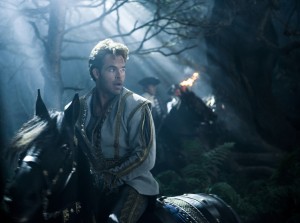 After several disappointing films (“Nine”), director Rob Marshall is back on terra ferma with his screen adaptation of “Into the Woods,” based on the beloved 1987 Broadway musical by Stephen Sondheim and James Lapine.
After several disappointing films (“Nine”), director Rob Marshall is back on terra ferma with his screen adaptation of “Into the Woods,” based on the beloved 1987 Broadway musical by Stephen Sondheim and James Lapine.
The stage production represented an original conception of half a dozen fairy tales and characters that over the years have become mythic and iconic in pop culture.
 Faithful to the source material, the new musical movie is darkly comic and rather enjoyable–if also uninspired and only sporadically touching.
Faithful to the source material, the new musical movie is darkly comic and rather enjoyable–if also uninspired and only sporadically touching.
Boasting a stellar cast, Into the Woods also benefits from polished production values, but it is staged in an impersonal way, lacking the distinction and gravitas that had defined “Sweeney Todd,” the 2007 big-screen rendition, directed by Tim Burton, of another admired stage musical from Sondheim.
Sondheim is the creative genius who has singlehandedly left his stamp on the musical genre over the past half a century (yes, he goes back to “West Side Story”).
More than anything else, this movie reflects our fascination with remixing, rebooting, or reinventing well-known fictional characters, including Little Red Riding Hood, Big Bad Wolf, Cinderella, Rapunzel, and others, and placing them in one likable tale.
 Like the stage version, Marshall’s movie is postmodern in the sense of taking a satirical, darkly humorous and detached look at these tales. This strategy is marked by two tendenceis. On the one hand, Marshall tries to humanize all the characters, and on the other, he complicates them by making them more ambiguous. All this is done in an effort of making the characters’ desires and dreams, anxieties and fears seem more universal so that they connect with young contemporary audiences, who go to the movies.
Like the stage version, Marshall’s movie is postmodern in the sense of taking a satirical, darkly humorous and detached look at these tales. This strategy is marked by two tendenceis. On the one hand, Marshall tries to humanize all the characters, and on the other, he complicates them by making them more ambiguous. All this is done in an effort of making the characters’ desires and dreams, anxieties and fears seem more universal so that they connect with young contemporary audiences, who go to the movies.
The extended opening number, which introduces the central characters and their individual quests, is most impressive to the point where what comes after this sequence looks and sounds serviceable but not as brilliant.
The enchanted forest, the central locale of Into The Woods, brings together Cinderella (Anna Kendrick) longs to go to the palace ball, where she’ll meet a handsome prince (Chris Pine). Meanwhile, a baker (James Corden) and his wife (Emily Blunt) must perform special duties for the evil witch (Streep) so that she’ll lift a curse that has left them childless.
Teaming again with his frequent and brilliant collaborators, cinematographer Dion Beebe and editor Wyatt Smith, Marshall doesn’t radically reimagine the story, nor does he have a new or original take on the characters. Instead, his goal seems more modest and simple, creating an accessible mass entertainment, based on an all-star casting.
Visually, Into the Woods could be more magical and enchanting than it is. Shot at Shepperton Studios, the film is designed by the distinguished artist Dennis Gassner, but even he is constrained by the limitations of making a film on sound stages. End result is a semi-effective screen rendition, marked by too much artifice, a musical that uneasily hovers between the world of theater and the world of cinema.











